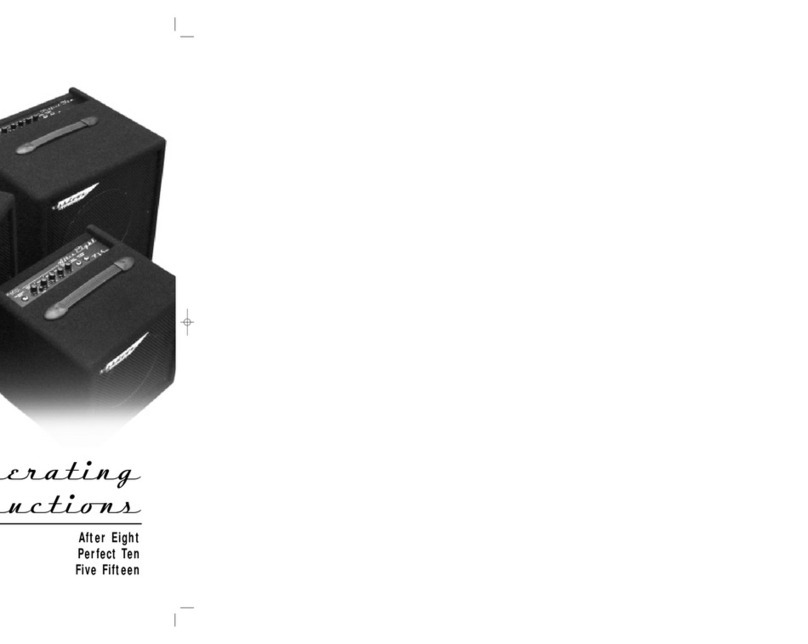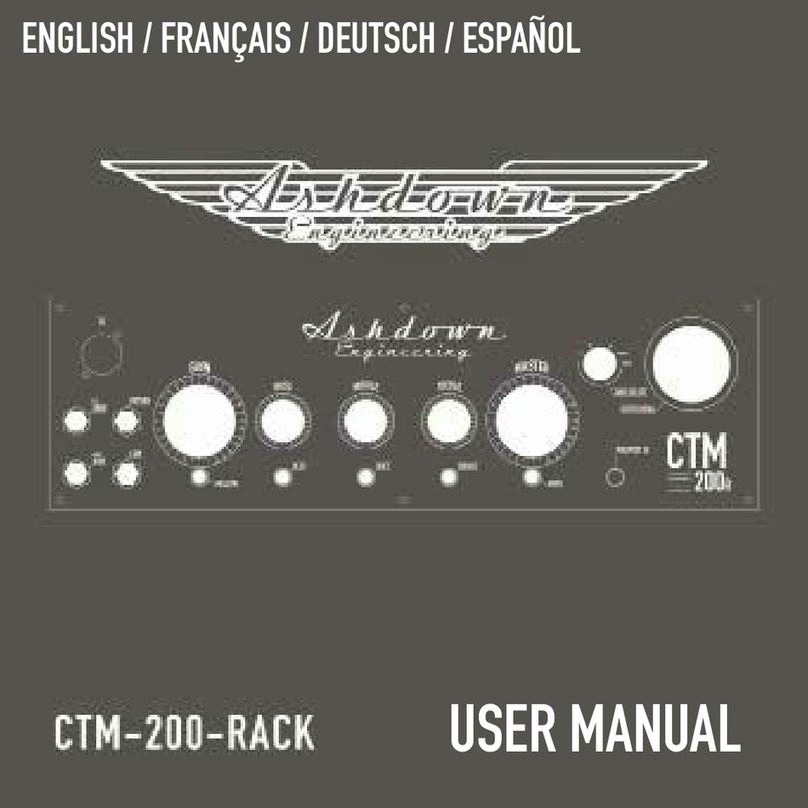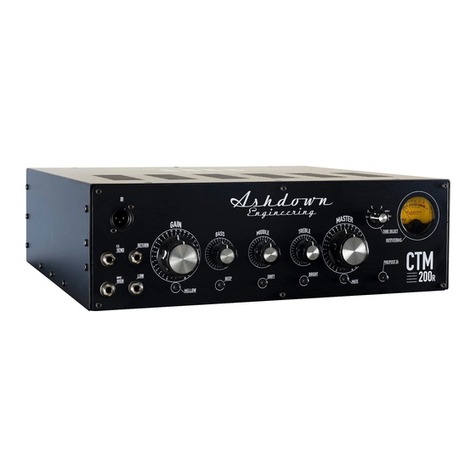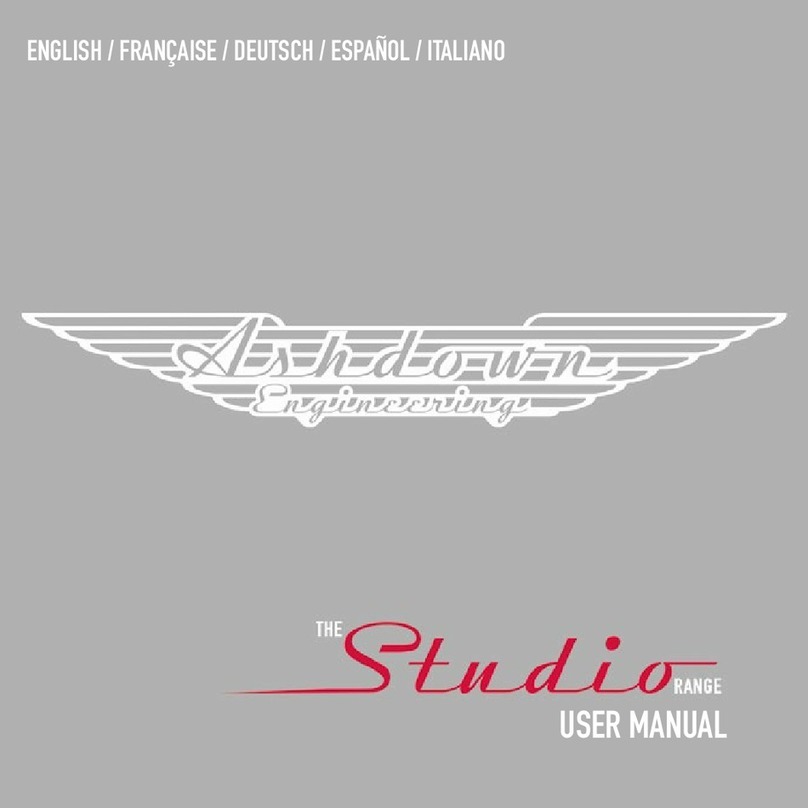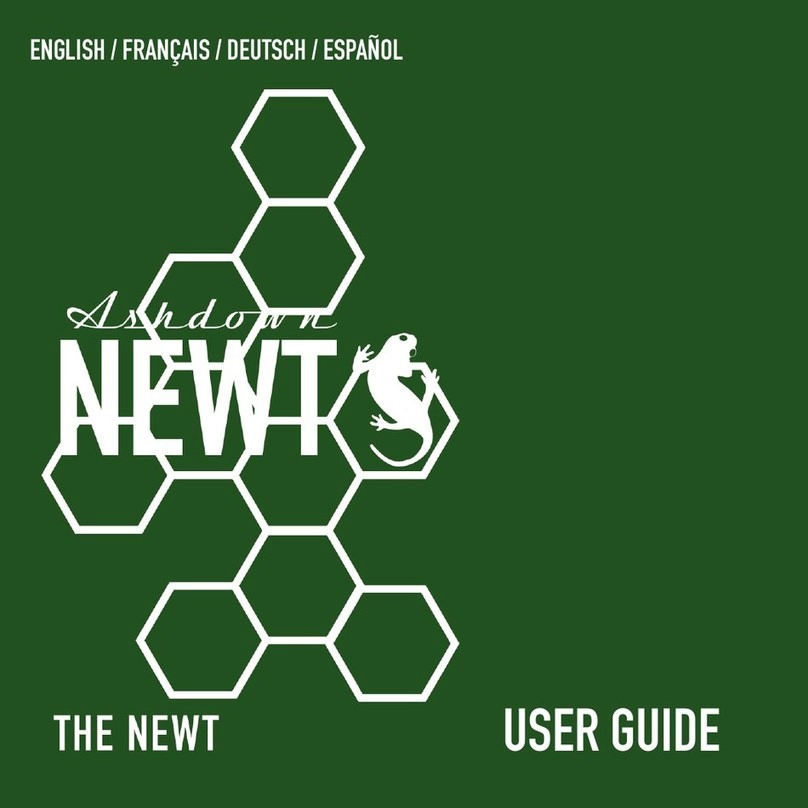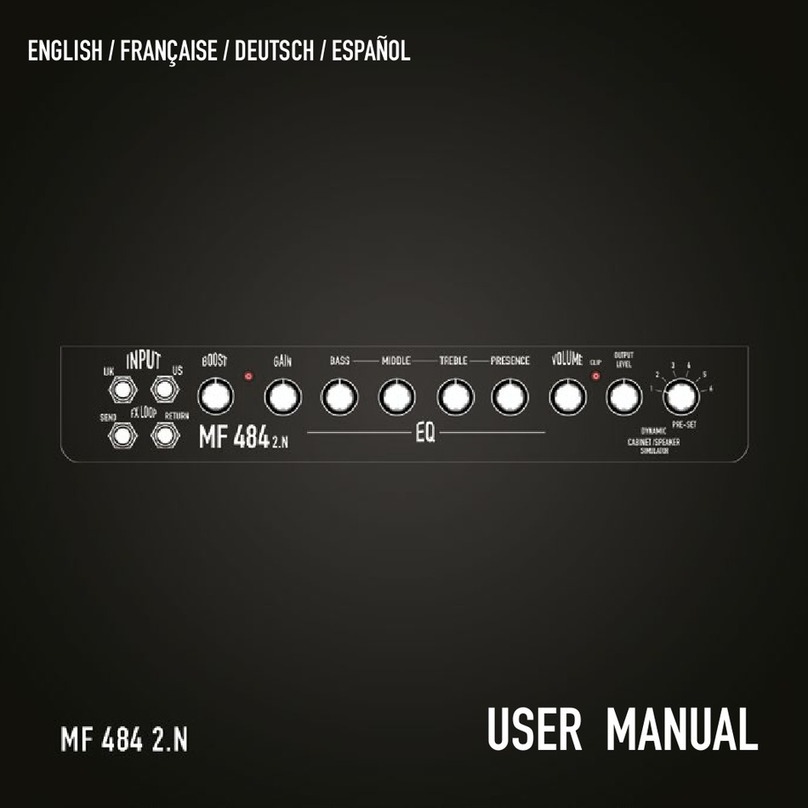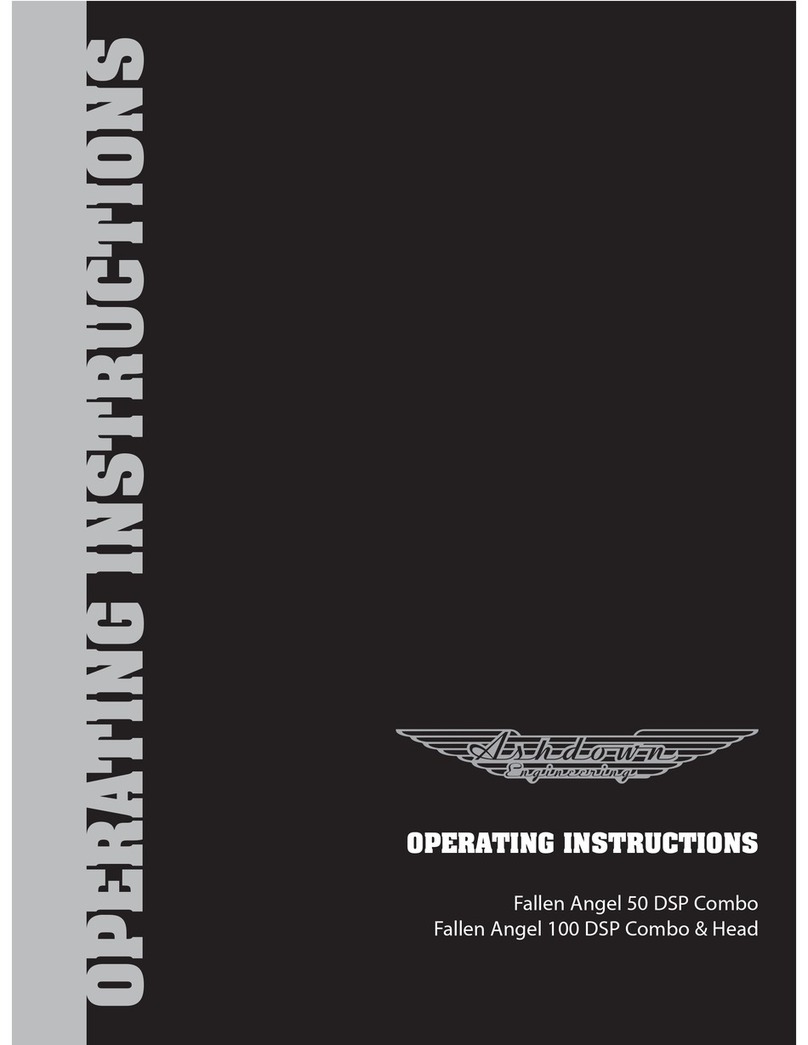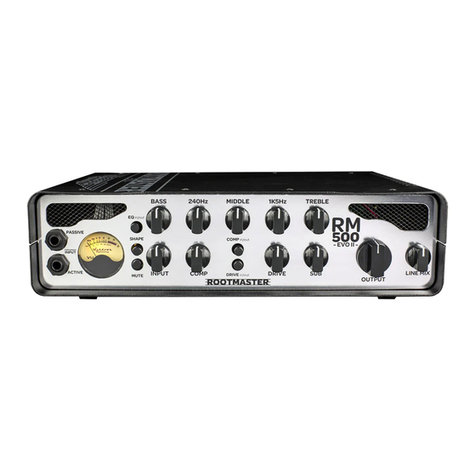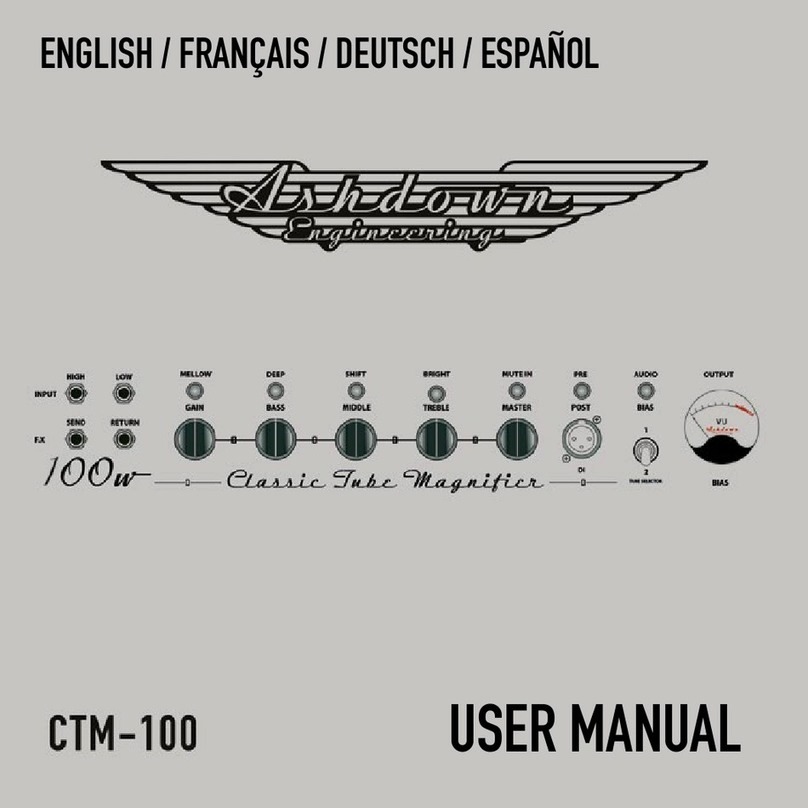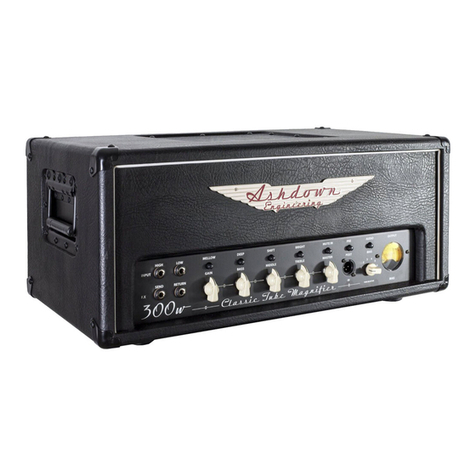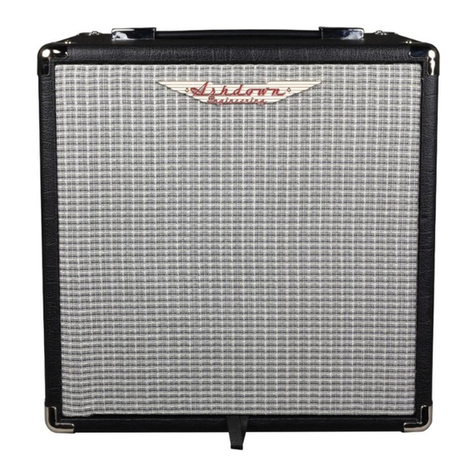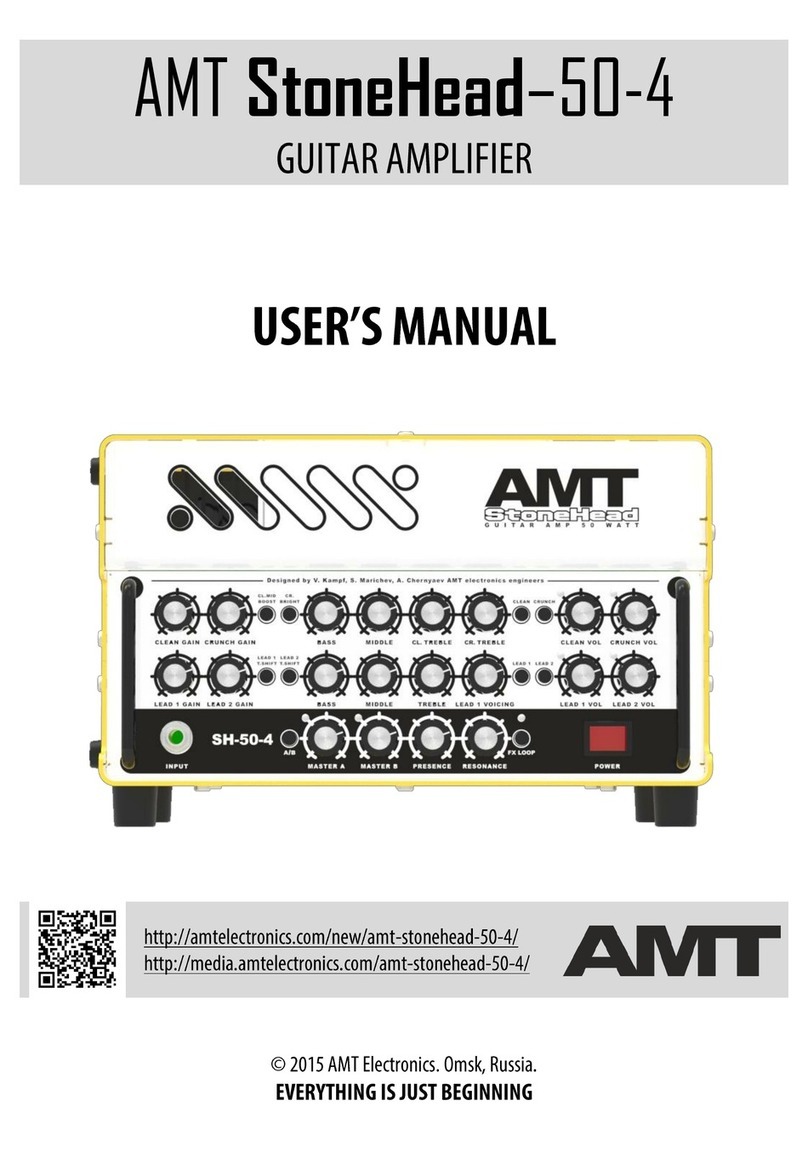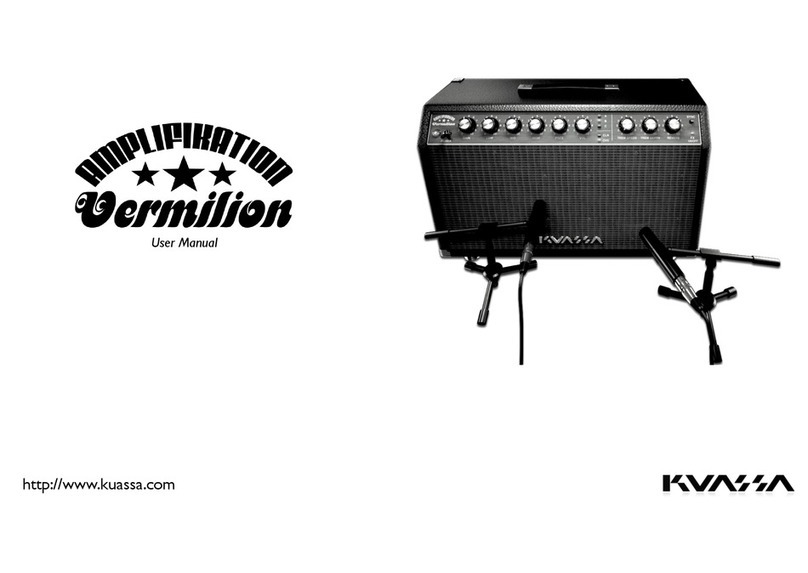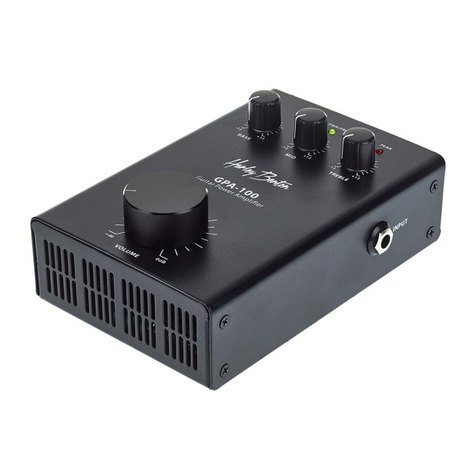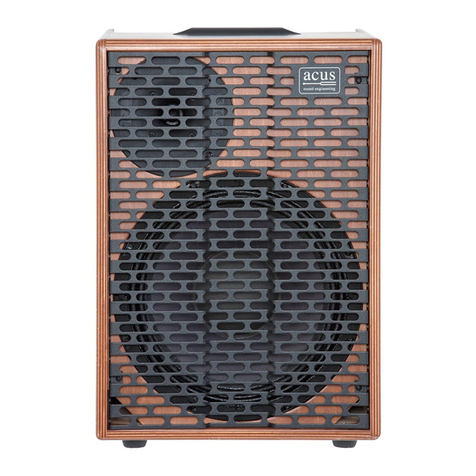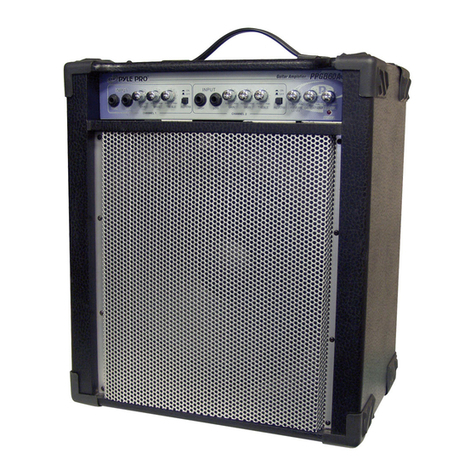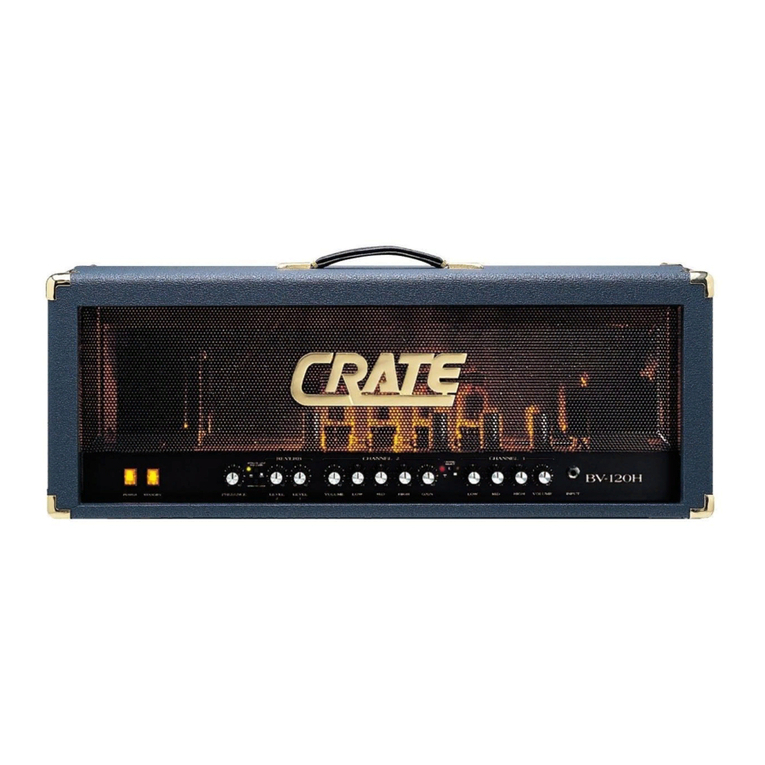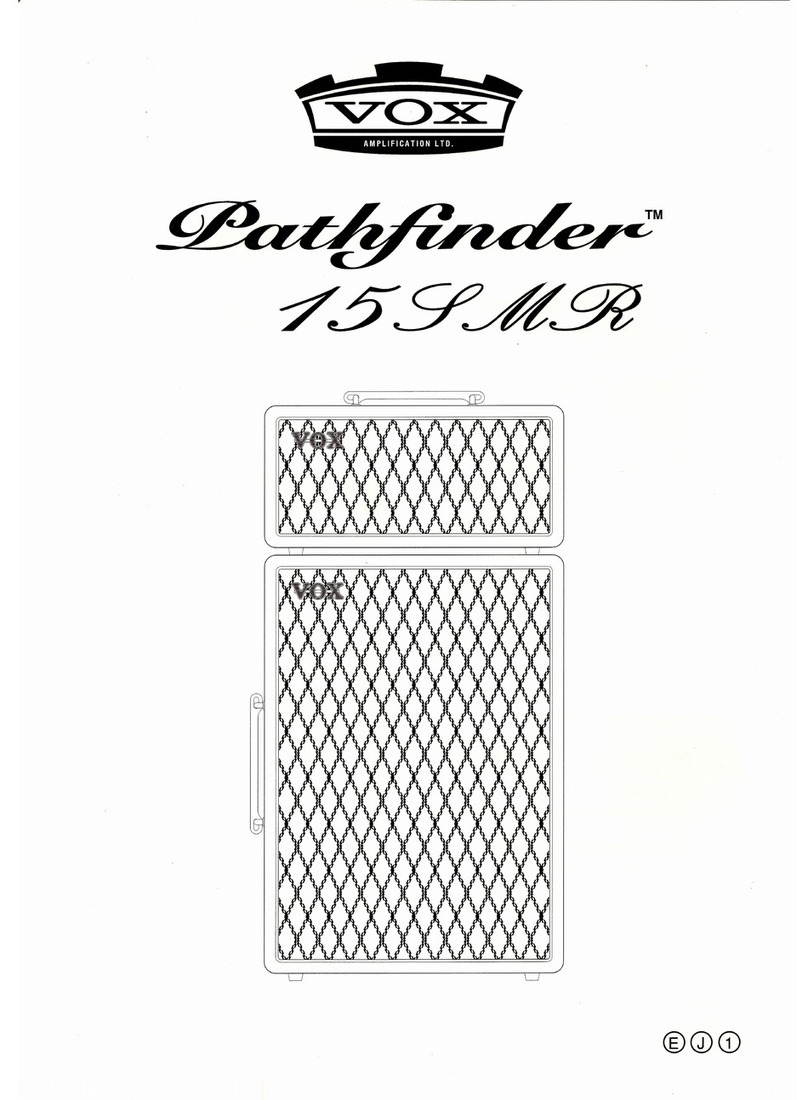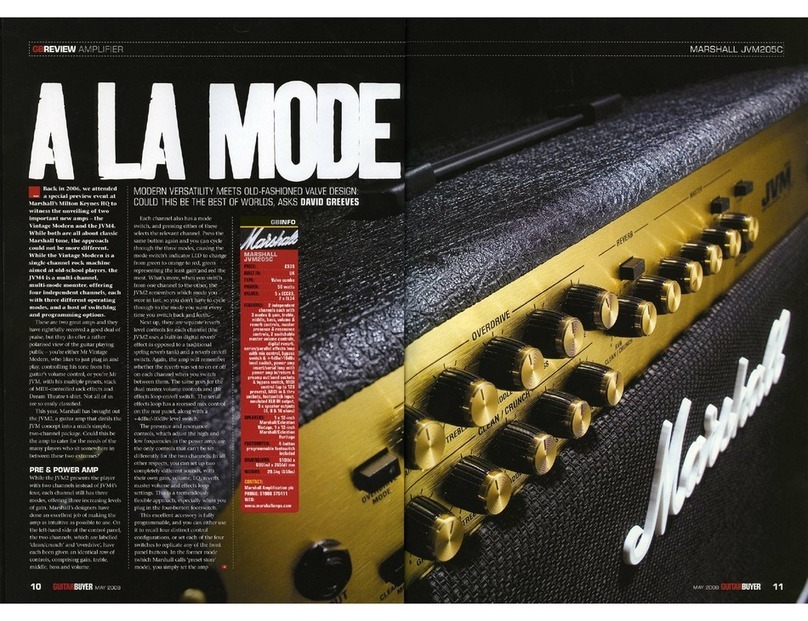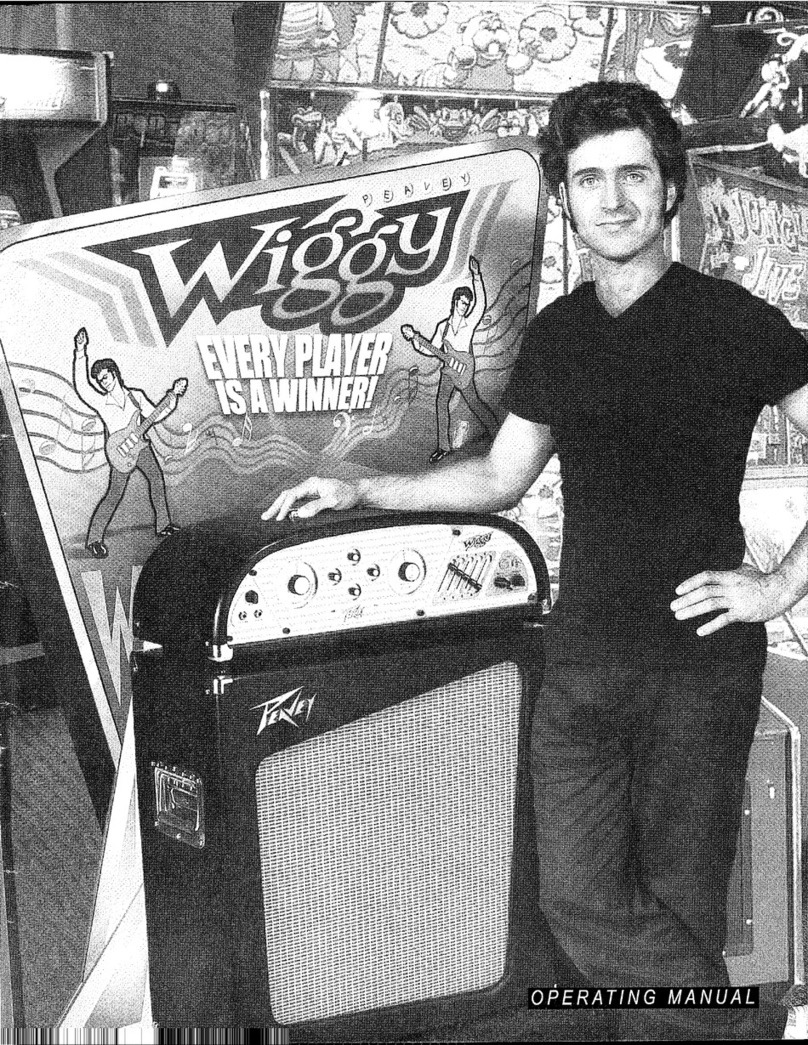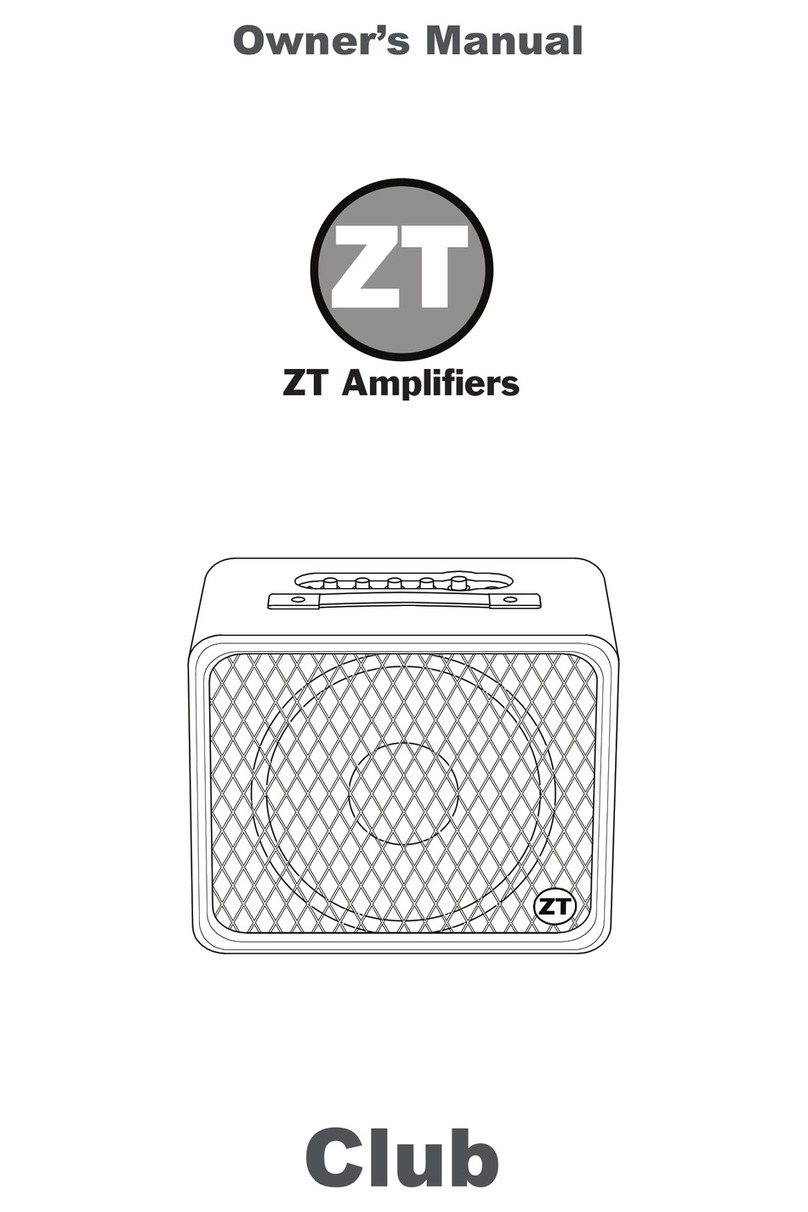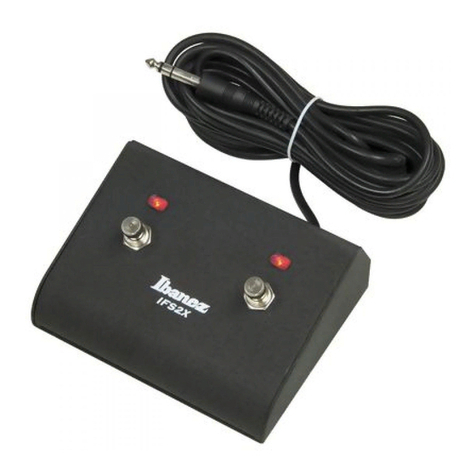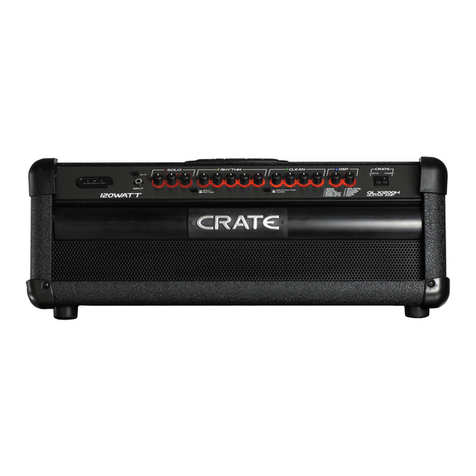
LITTLE BASTARD 2.N USER GUIDE LITTLE BASTARD 2.N USER GUIDE
CC Range
00-1 0 = Off ; 1 = On
10-7
20-30 0 = 0dB ; 30 = 30dB
30-127 0 = 0% ; 63 = 50% ; 127 = 100%
40-127 0 = 0% ; 63 = 50% ; 127 = 100%
50-1 0 = Triode ; 1 = Pentode
60-1 0 = Off ; 1 = On
7N.A. N.A.
8
9
10
11 0-3 0= User 0 ; 1= User1; 2 = User 2 ; 3 = User 3
12 0-3 0= User 0 ; 1= User1; 2 = User 2 ; 3 = User 3
13 0-7
14 0-127 0 = 0% ; 63 = 50% ; 127 = 100%
15 0-127 0 = 0% ; 63 = 50% ; 127 = 100%
16 0-1 0 = Back ; 1 = Front
35 0-107 0 = -95dB ; 95 = 0dB ; 107 = 12dB
36 0-1 0 = Normal ; 1 = Invert
37 0-1 0 = Off ; 1 = On (Mute)
38 0-7
39 0-127 0 = 0% ; 63 = 50% ; 127 = 100%
40 0-127 0 = 0% ; 63 = 50% ; 127 = 100%
41 0-1 0 = Back ; 1 = Front
42 0-107 0 = -95dB ; 95 = 0dB ; 107 = 12dB
43 0-1 0 = Normal ; 1 = Invert
44 0-1 0 = Off ; 1 = On (Mute)
51 0-1 0 = Off (Mic ON) ; 1 = On (Mic Bypass)
52 0-1 0 = Off (Mic ON) ; 1 = On (Mic Bypass)
EQ
On/Off 17 0-1 0 = Off ; 1 = On
Mode 18 0-2 0 = Guitar ; 1 = Bass ; 2 = Custom
19 0-40 0 = -20dB ; 20 = 0dB ; 40 = 20dB
20 0-40 0 = -20dB ; 20 = 0dB ; 40 = 20dB
21 0-40 0 = -20dB ; 20 = 0dB ; 40 = 20dB
22 0-40 0 = -20dB ; 20 = 0dB ; 40 = 20dB
23 0-40 0 = -20dB ; 20 = 0dB ; 40 = 20dB
45 0-127 Specific mapping to Hz
46 0-127 Specific mapping to Hz
47 0-127 Specific mapping to Hz
48 0-127 Specific mapping to Hz
49 0-127 Specific mapping to Hz
50 0-127 Specific mapping to Hz
24 0-95 0 = -95dB ; 95 = 0dB
On/Off 25 0-1 0:Off 1:On
26 0-7
27 0-127 0 = 0% ; 63 = 50% ; 127 = 100%
53 0-127 0 = 0% ; 63 = 50% ; 127 = 100%
54 0-127 0 = 0% ; 63 = 50% ; 127 = 100%
55 0-127 0 = 0% ; 63 = 50% ; 127 = 100%
Type 56 0-1
Param Behaviour
0 = Model #0 ; 1 = Model #1...
Presence
Depth
Character
Cab/Mic
Unused
0-num files 0 = Cab #0 ; 1 = Cab #1...
0-num files 0 = File #0 ; 1 = File #1...
0-num files 0 = File #0 ; 1 = File #1...
0 = Mic #0 ; 1 = Mic #1...
0 = Mic #0 ; 1 = Mic #1...
Level B
Bypass A
Bypass B
Gain: Low
Gain: Low Mid
Gain: Mid
Gain: High Mid
Gain: High
Freq: Low Cut
Freq : Low
Freq: Low Mid
Freq: Mid
Freq: High Mid
Freq: High
Level
Preset Level
Reverb
Preset 0 = Room #0 ; 1 = Room #1...
Dry Wet
Size
Echo
Color
0:Room 1:Ambience
Noise Gate
CC Range
On/Off 00-1 0 = Off ; 1 = On
10-7
Volume 20-30 0 = 0dB ; 30 = 30dB
30-127 0 = 0% ; 63 = 50% ; 127 = 100%
40-127 0 = 0% ; 63 = 50% ; 127 = 100%
50-1 0 = Triode ; 1 = Pentode
On/Off 60-1 0 = Off ; 1 = On
7N.A. N.A.
Cab 8
File A 9
File B 10
11 0-3 0= User 0 ; 1= User1; 2 = User 2 ; 3 = User 3
12 0-3 0= User 0 ; 1= User1; 2 = User 2 ; 3 = User 3
13 0-7
Distance A 14 0-127 0 = 0% ; 63 = 50% ; 127 = 100%
Center A 15 0-127 0 = 0% ; 63 = 50% ; 127 = 100%
Position A 16 0-1 0 = Back ; 1 = Front
35 0-107 0 = -95dB ; 95 = 0dB ; 107 = 12dB
Phase A 36 0-1 0 = Normal ; 1 = Invert
Mute A 37 0-1 0 = Off ; 1 = On (Mute)
38 0-7
Distance B 39 0-127 0 = 0% ; 63 = 50% ; 127 = 100%
Center B 40 0-127 0 = 0% ; 63 = 50% ; 127 = 100%
Position B 41 0-1 0 = Back ; 1 = Front
42 0-107 0 = -95dB ; 95 = 0dB ; 107 = 12dB
Phase B 43 0-1 0 = Normal ; 1 = Invert
Mute B 44 0-1 0 = Off ; 1 = On (Mute)
51 0-1 0 = Off (Mic ON) ; 1 = On (Mic Bypass)
52 0-1 0 = Off (Mic ON) ; 1 = On (Mic Bypass)
EQ
On/Off
17 0-1 0 = Off ; 1 = On
18 0-2 0 = Guitar ; 1 = Bass ; 2 = Custom
19 0-40 0 = -20dB ; 20 = 0dB ; 40 = 20dB
20 0-40 0 = -20dB ; 20 = 0dB ; 40 = 20dB
21 0-40 0 = -20dB ; 20 = 0dB ; 40 = 20dB
22 0-40 0 = -20dB ; 20 = 0dB ; 40 = 20dB
23 0-40 0 = -20dB ; 20 = 0dB ; 40 = 20dB
45 0-127 Specific mapping to Hz
46 0-127 Specific mapping to Hz
47 0-127 Specific mapping to Hz
48 0-127 Specific mapping to Hz
49 0-127 Specific mapping to Hz
50 0-127 Specific mapping to Hz
24 0-95 0 = -95dB ; 95 = 0dB
25 0-1 0:Off 1:On
26 0-7
27 0-127 0 = 0% ; 63 = 50% ; 127 = 100%
53 0-127 0 = 0% ; 63 = 50% ; 127 = 100%
54 0-127 0 = 0% ; 63 = 50% ; 127 = 100%
55 0-127 0 = 0% ; 63 = 50% ; 127 = 100%
Type 56 0-1
Param Behaviour
Power Amp
Model 0 = Model #0 ; 1 = Model #1...
Presence
Depth
Character
Cab/Mic
Unused
0-num files 0 = Cab #0 ; 1 = Cab #1...
0-num files 0 = File #0 ; 1 = File #1...
0-num files 0 = File #0 ; 1 = File #1...
Folder A
Folder B
Mic A 0 = Mic #0 ; 1 = Mic #1...
Level A
Mic B 0 = Mic #0 ; 1 = Mic #1...
Level B
Bypass A
Bypass B
Gain: Low
Gain: Low Mid
Gain: Mid
Gain: High Mid
Gain: High
Freq: Low Cut
Freq : Low
Freq: Low Mid
Freq: Mid
Freq: High Mid
Freq: High
Level
Preset Level
Reverb
Preset
0 = Room #0 ; 1 = Room #1...
Dry Wet
Size
Echo
Color
0:Room 1:Ambience
Noise Gate
